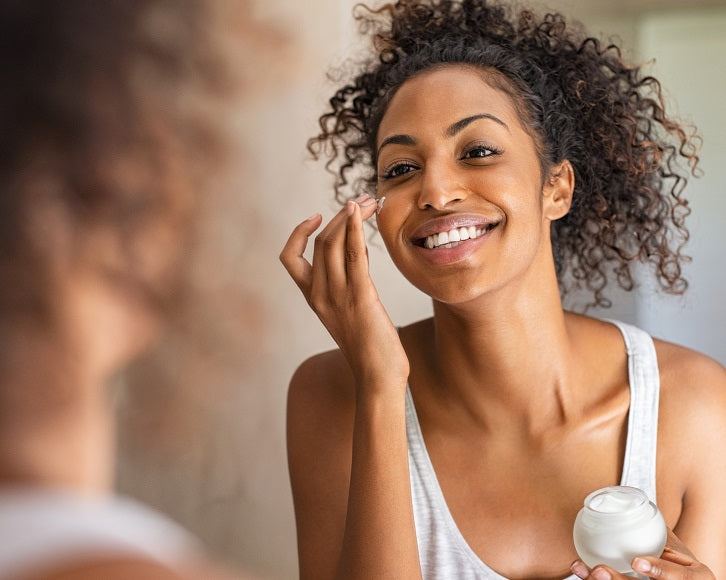Best Skin Moisturizer Application Practices

It is important to know the right skin moisturizer application practice if you want the best results - or any results! During the winter dry months, we commonly hear at the dermatology practice: "I moisturize daily but still have dry skin. Am I doing something wrong or should I be using a different moisturizer?" The answer to this question depends on,
- how you use your moisturizer, and
- the ingredients in your moisturizer.
Best Skin Moisturizer Application Practices
Patients become even more distressed as their dry skin develops into eczema and other dry skin conditions. To address these questions, Dr. Cynthia Bailey details the best skin moisturizer practices in her article on Dry Skin Care. Plus, to treat dry skin you must first understand what causes dry skin.
The Causes of Dry Skin
There are various reasons for dry skin, ranging from environmental factors to genetics.
-
Environment: Dry and low humidity climates "pull" the water out of your skin, resulting in dry skin and chapping.
-
Harsh Products: Soaps and solvents remove not only dirt but also your skin's natural oils, damaging your top layer of skin cells.
-
Hot Water: This has a similar effect to how harsh products cause dry skin.
-
Age: Our skin produces less oils as we age, making us more prone to dry skin.
-
Genetics: You were born with it, and may have a family history of asthma, eczema, or hay fever.
No matter the reason, to have a healthy skin barrier requires the proper hydration. Moisturizers are vital to your skin barrier health, but the application of moisturizers and other skin care practices are just as important, as we will explain below.
What are the Best Skin Moisturizer Application Practices?
1. Skin Bathing and Cleansing Methods
Bathing is part of your daily routine for hygiene and skin health. However, there are bathing practices that damage your skin barrier.
-
Hot Water Temperature: As discussed earlier, steamy or hot water strips the top layer of your skin of its natural oils leading to dry or inflamed skin. Bathing in lukewarm water prevents - and even heals - dry skin.
-
Over-soaping: Soap is designed to remove grease and oil, so try to minimize its use to the oily areas of the skin. These areas include: face, armpits, buttocks, groin, and feet.
-
Harsh Soap Strength: While some skin conditions require medicated or harsh soaps, try to use only mild soaps to cleanse your skin. Mild soaps should have excess alkali removed, some level of glycerin, and be gentle enough for even sensitive skin. Dr. Bailey's favorite mild soaps with these qualities are: Extremely Gentle Facial Cleanser (pH balanced), Naturally Best Bar Soap for Dry Skin (certified organic, hypoallergenic and fragrance-free, economical and perfect for the entire family), Natural Foaming Liquid Hand Soap (also fragrance-free, economical, perfect for the entire family and the best soap to have at every sink for hand washing).
2. Skin Moisturizing Application Methods
A healthy skin barrier consists of hydrated skin: skin layers with a mixture of water and oil. Oil helps hydrate the skin by trapping water into its layers and protecting it from harmful substances or evaporation. Moisturizer aids in providing additional oils or maintaining the skin's current oils. In order for moisturizers to be useful, you must be mindful of how they apply their moisturizers.- Apply moisturizers three minutes after bathing or cleansing. Dr. Bailey calls this "the magic 3-minute rule". While bathing, your skin absorbs water but will be prone to evaporation after you towel off to dry. It is essential to apply a thin layer of moisturizer or lotion to your skin within three minutes after toweling off to dry.
- Moisturizer ingredients. Rich and deeply moisturizing ingredients are necessary to heal dry or damaged skin. Some examples include:
- Pure oils: Jojoba oil, coconut oil, avocado oil, sunflower oil, extra virgin olive oil, etc.
- Butters: Shea butter or cocoa butter
- Water-binding ingredients such as glycerin.
- For severely dry and chapped skin, look for high oil ointments with lanolin, petrolatum or shea butter.
3. Best Moisturizer Products
Dr. Bailey's favorite moisturizers have combination of all the ingredients discussed above and sell at affordable prices. In her practice and her own daily skin care routine, Dr Bailey uses her Natural Face and Body Butter Cream or Natural Face, Hand, and Body Lotion. These ultra rich and healing moisturizers are deeply moisturizing and do not leave your skin feeling oily.
The most common area for dry skin is your hands, which are washed constantly throughout your day. It is important to moisturize your hands multiple times a day and Dr. Bailey's Dry Skin Hand Cream is highly effective. Her Dry Hand Skin Repair Kit covers the basics for daily dry skin hand care. It includes a non-drying soap and cotton gloves to use with her hand cream or lanolin containing Bag Balm ointment.
If you would like a more thorough discussion on the best skin moisturizer practices, read Dr. Bailey's article on Dry Skin Care.
Sincerely, Dr. Bailey Skin Care Team







